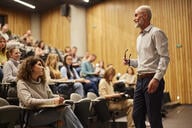You have /5 articles left.
Sign up for a free account or log in.
We have lots of spirited conversations about the challenges of teaching in higher education, but no topic is more contentious than whether or not we should lecture in the classroom. Some people passionately defend the lecture, including Molly Worthen in The New York Times a few years ago, while others take a similar view to Nobel laureate Carl Wieman, who has described lecturing as “the pedagogical equivalent of bloodletting.” Quite a gulf exists between those two positions.
Lecturing is often pitted against what is commonly called active learning, an umbrella category that encompasses a variety of interactive, evidence-based teaching strategies designed to enhance student learning. This dichotomy suggests that instructors are teaching entirely in one way or in the other, and never the twain shall meet. It’s a convenient binary that rallies the troops, but if the goal is to advance our understanding of effective educational methods, then it really just serves to eliminate nuance and muddy the waters.
The reality of day-to-day practices in colleges and universities across the country is much more complicated than this neatly packaged argument would have us believe. After 12 years of working with faculty members on teaching initiatives at three different universities, it is clear to me that definitions of the term “lecture” vary widely among individuals -- and those differences are evident in the way lecturing is carried out in the classroom.
For some faculty members, lecturing means nonstop talking or “continuous exposition,” as Donald Bligh, Derek Bruff and others have called it. In that model, faculty members often see their role more akin to being authors than tutors, to use Elizabeth Barre’s framing of the issue. They typically give students some time to ask questions in the continuous exposition format, but overall the experience is largely a passive one.
That form of lecturing may be the one that dominates popular culture, and it is the mode of lecturing that we frequently see described in the press as well. But not all faculty members agree with this conceptualization of lecturing. For many, lecturing consists of a significant amount of talking with time set aside for a substantial activity or discussion. Still other faculty members envision lecturing as equal parts talking and active learning. Some even call it lecturing if they are talking for a little while but most of the class session is interactive.
I put together a very small Twitter poll over the summer that asked the following question: “When you think of what it means to lecture, what do you envision and/or practice in your classroom?” Of the 64 respondents, only 11 percent said that they believed lecturing to consist of “nonstop talking.” Another 39 percent saw it as primarily comprised of instructor-driven content with some activities included. And the final 47 percent thought lecturing was either an equal balance of the content delivery and activity or that it was tipped more toward student interaction than to talking.
The survey is obviously not representational because the sample size is infinitesimal and, what’s more, most people I interact with on social media are outspoken proponents of active learning. But I think it is illustrative of the differences in the way lecturing is conceptualized.
Try asking folks on your own campus about their definitions of their lecturing practice. Once you start the conversation, it’s surprising how disparate the perspectives can be. Calls to abolish the lecture, then, are futile because methods diverge so widely. Arguments that advocate for faculty members to abandon lectures wholesale also risk alienating those who are, in fact, already implementing active learning strategies into what they are calling a lecture.
The research clearly tells us that: 1) the continuous exposition variety of lecturing negatively affects student learning, especially those students from underrepresented groups and 2) well-designed interactive strategies that focus on conceptual development improve student learning. (The “well-designed” part is important there.) Beyond those fundamental principles, though, we actually have to look at what is happening in our classrooms to determine the shape of our discussions about teaching effectiveness.
Relatively short lectures with interspersed activities are very useful, particularly if our goal is to provide students with context or describe a scholarly debate in our field or the like. So if a “lecture” actually includes a lot of interaction, then we really need to be worrying less about the talking and thinking more about what the activities look like. Are they the sorts of activities that will maximize student learning? How are they designed? What are the goals? These strike me as far more important concerns than timing the lecture portion with a stopwatch.
Above all else, we need to listen to each other and clearly define the terms of our debate if we are going to change higher education for the better.




